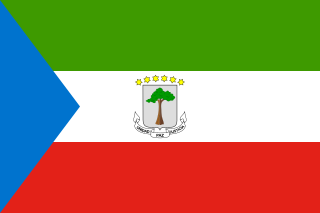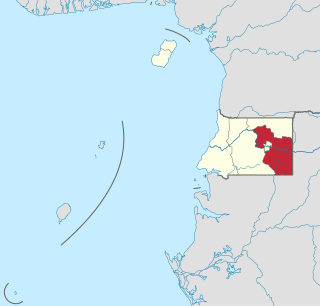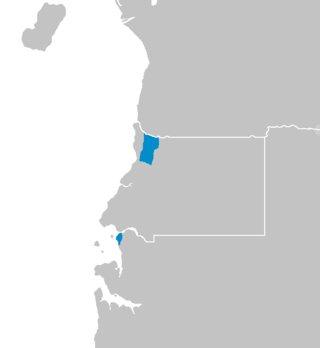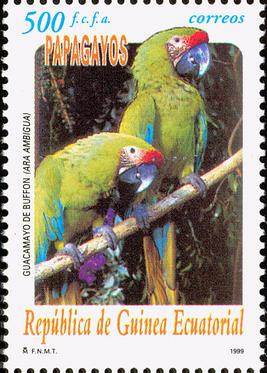
Equatorial Guinea, also rarely known as Equatoguinea, officially the Republic of Equatorial Guinea, is a country on the west coast of Central Africa, with an area of 28,000 square kilometres (11,000 sq mi). Formerly the colony of Spanish Guinea, its post-independence name refers to its location near both the Equator and in the African region of Guinea. As of 2021, the country had a population of 1,468,777, over 85% of whom are members of the Fang people, the country's dominant ethnic group. The Bubi people, indigenous to Bioko, are the second largest group at approximately 6.5% of the population.

The History of Equatorial Guinea is marked by centuries of colonial domination by the Portuguese, British and Spanish colonial empires, and by the local kingdoms.

The Republic of Equatorial Guinea is located in west central Africa. Bioko Island lies about 40 kilometers (24.9 mi) from Cameroon. Annobón Island lies about 595 kilometres (370 mi) southwest of Bioko Island. The larger continental region of Río Muni lies between Cameroon and Gabon on the mainland; it includes the islands of Corisco, Elobey Grande, Elobey Chico, and adjacent islets. The total land area is 28,051 km2 (10,831 sq mi). It has an Exclusive Economic Zone of 303,509 km2 (117,185 sq mi).

Demographic features of the population of Equatorial Guinea include population density, ethnicity, education level, health of the populace, economic status, religious affiliations and other aspects of the population.

The Bight of Biafra is a bight off the west-central African coast, in the easternmost part of the Gulf of Guinea.
Fang is a Central African language spoken by around 1 million people, most of them in Equatorial Guinea, and northern Gabon, where it is the dominant Bantu language; Fang is also spoken in southern Cameroon, the Republic of the Congo, and small fractions of the islands of São Tomé and Príncipe. It is related to the Bulu and Ewondo languages of southern Cameroon.

Mbini is a town in Río Muni, Equatorial Guinea, lying at the mouth of the Benito River. Mbini is the Ndowe name for Río Muni. It is located 44 km southwest of Bata.

The Bubi people are a Bantu ethnic group of Central Africa who are indigenous to Bioko Island, Equatorial Guinea. Once the majority group in the region, the population experienced a sharp decline due to war and disease during Portuguese expeditions. By the end of Spanish colonial rule in the mid 20th century, and after substantial intermarriage with newly introduced populations, such as Afro-Cubans, Krio people, Portuguese people and Spaniards, the Bubi people, again, experienced a great decline in number. Seventy-five percent perished due to tribal/clan rooted political genocide during a civil war that led to Spanish Guinea's independence from Spain. This, too, sparked mass exodus from their homeland with most of the exiles and refugees immigrating into Spain. The indigenous Bubi of Bioko Island have since co-existed with non-indigenous Krio Fernandinos; and members of the Fang ethnic group, who have immigrated in large numbers from Río Muni. Once numbering approximately 3 million, the Bubi currently number around 100,000 worldwide.

Spanish Guinea was a set of insular and continental territories controlled by Spain from 1778 in the Gulf of Guinea and on the Bight of Bonny, in Central Africa. It gained independence in 1968 as Equatorial Guinea.

Elobey, Annobón, and Corisco was a colonial administration of Spanish Africa consisting of the island of Annobón, located southwest of São Tomé and Príncipe in the Gulf of Guinea, and the small islands of Elobey Grande, Elobey Chico, and Corisco, located in the Corisco Bay near the mouth of the Mitémélé River in the Muni Estuary.
The Fang-Beti are a Bantu ethnic group located in rain forest regions of Cameroon, Republic of the Congo, Equatorial Guinea, Gabon, and São Tomé and Príncipe. Though they separate themselves into several individual clans, they all share a common origin, history and culture Estimated to be well over 8 million individuals in the early 21st century, they form the largest ethnic group in central Cameroon and its capital city of Yaoundé, in Gabon, and in Equatorial Guinea. Their Beti languages are mutually intelligible.

The Fang people, also known as Fãn or Pahouin, are a Bantu ethnic group found in Equatorial Guinea, northern Gabon, and southern Cameroon. Representing about 85% of the total population of Equatorial Guinea, concentrated in the Río Muni region, the Fang people are its largest ethnic group. The Fang are also the largest ethnic group in Gabon, making up about a quarter of the population.

Litoral is the most populous province of Equatorial Guinea, recording a population of 367,348 in the 2015 national census. Its capital is Bata; the other two cities are Mbini and Kogo.

Wele-Nzas Province is a province in the eastern portion of continental Equatorial Guinea. Its capital is Mongomo. It borders the Equatoguinean provinces of Centro Sur to the west and Kié-Ntem to the north, with Gabon's Woleu-Ntem Province to the east and south. As of 2015, the population of Wele-Nzas was 192,017. It derives its name from the Benito River and the Piedra Nzas mountain range.
Equatoguinean Spanish is the variety of Spanish spoken in Equatorial Guinea. This is the only Spanish variety that holds national official status in Sub-Saharan Africa. It is regulated by the Equatoguinean Academy of the Spanish Language and is spoken by about 90% of the population, estimated at 1,170,308 for the year 2010, all of them second-language speakers.

The Benga people are an African ethnic group, members of the Bantu peoples, who are indigenous to Equatorial Guinea and Gabon. Their indigenous language is Benga. They are referred to as Ndowe or Playeros, one of several peoples on the Río Muni coast. Bengas inhabit a small coastal portion of the Cabo de San Juan, suburban enclaves in the coastal municipalities of Mbini and Bata, and the islands of Corisco, Elobey Grande and Elobey Chico.

Seki, also Baseke, Sheke or Sekiana, is a language indigenous to Equatorial Guinea and Gabon. It had been spoken in villages of Rio Campo and Northern Bata, along the coast, but its native speakers have begun abandoning the language for Spanish, Fang, and Kombe. Can be related to Kako spoken in the East region of Cameroon and some parts of the west of Central African Republic.

This is a survey of the postage stamps and postal history of Equatorial Guinea, formerly known as Spanish Guinea.

The Popular Idea of Equatorial Guinea was a nationalist political group created at the end of the 1950s with the goal of establishing independence in Equatorial Guinea. The IPGE is considered to be the first formal Equatoguinean political party. The IPGE was founded by a group of exiles living in Gabon and Cameroon, with their official headquarters in Ambam. Early party leaders included Clemente Ateba, José Perea Epota, Antonio Eqoro, Jaime Nseng, and Enrique Nvó, who was credited for starting the IPGE during his time in exile in Ambam. Nvo's radical political ideas and his rise to power in sections of northern Rio Muni concerned Spanish authorities, who allegedly paid contract killers to assassinate him in 1959.
The Province of Río Muni was a former Spanish province in Africa. It consists of modern-day Equatorial Guinea plus the islands of Corisco and Elobey. It borders Gabon to the east and south and Cameroon to the north. Its administrative capital is Bata.
















